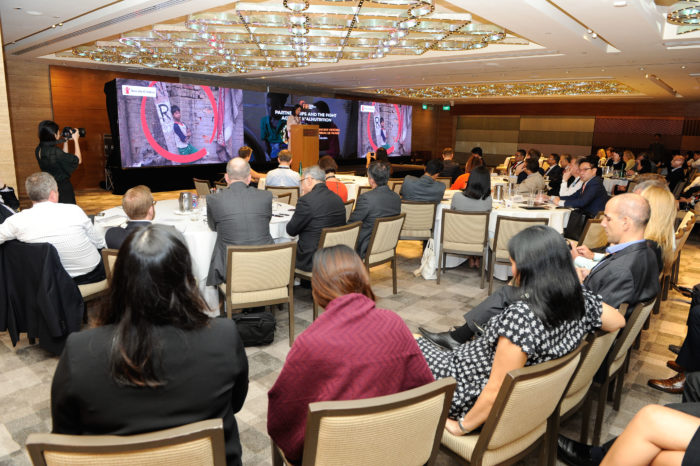
News & Events
Sufficient Food and Nutrition for Every Child: Innovation and Partnership in the Fight against Malnutrition
By Food Industry Asia (FIA)
For the first time in 17 years, according to the Dutch Broadcasting Services (NOS), the number of people threatened by hunger around the world has risen yet again. Statistics show us that globally, one in nine people suffer from food insecurity, and more than 200 million children are malnourished. The battle we have been fighting against malnutrition is not over yet.
The consequences of malnutrition are disastrous. A child can suffer from growth deficits due to malnutrition, as a result of a lack of proper nutrition within the first thousand days of his or her life – from the moment of conception, up till his or her second birthday. For malnourished children, this causes a lag in both physical and mental development – parts of the growth process that are often difficult to reverse.
Chronically malnourished children are more susceptible to diseases, do not perform well at school, tend to end up in poorer-paid jobs, and thus are less likely to break out of the vicious cycle of poverty. Malnutrition not only takes lives; it also inhibits the economic development of individuals and the community. An example of this effect: In Papua New Guinea, a bewildering one in two children struggles with inhibited growth due to malnutrition, compared with more than one in five in the rest of the world.

Her Royal Highness Princess Viktória de Bourbon de Parme speaking at the Food Industry Asia’s Food for the Future Summit on 26 April at the Grand Hyatt in Singapore
Moving beyond economic goals with targeted programmes
Until recently, it was believed that continued economic growth would automatically reduce rates of malnutrition in a country. The World Bank even estimated that an annual growth of 5 per cent of a country’s gross domestic product (GDP) would lead to a decrease of chronic malnutrition by 0.9 percentage points per year – namely a type of trickle-down effect, or a “formula of hope”. However, that hope appears to be vain.
Papua New Guinea’s economy grew over 14 consecutive years, and even by 8 per cent in 2014. Simultaneously, however, the number of children suffering from chronic malnutrition increased during this time – from 43 per cent to 49.5 per cent. This outcome is in line with research conducted in other countries, which shows that rapid economic growth has little effect on the reduction of malnutrition, if it is not accompanied by targeted investments and interventions to improve nutrition intake.
China, Brazil and Thailand are good examples that prove the success of targeted programmes, having experienced an increase in economic growth and reduction of malnutrition. In fact, the Global Nutrition Report 2014 shows that every euro invested in combating malnutrition yields an average of €16, as individuals start to participate in national development. Apart from purely economic reasons to combat malnutrition, international treaties and agreements entitle each child to sufficient healthy and nutritious food.
The global community has agreed to work together to realise the United Nations’ 17 Sustainable Development Goals (SDGs) by 2030. The fight against malnutrition – especially in children – forms the basis for 12 of these goals, and can only be won by broadly applying sustainable methods to improve agriculture, education, food systems, water and hygiene, and especially the access to healthy food. By working together with the private sector, investing in countries with development aid, and through very targeted agricultural projects, innovation and fair trade between countries, major steps can be made.
Economic growth of a country does not automatically result in provision of better nutrition for the population. The fight against malnutrition requires more – it is about vision, investments and tenacity. This is important not just for economic development, but also for the health of entire generations of malnourished children.
Partnerships and innovative solutions to meet collective goals
In our world today, where a variety of stakeholders are confronted by multiple challenges related to high malnutrition rates, it is essential that we explore innovative routes to tackle malnutrition and food insecurity. Apart from the fact that an integrated approach combining health and agricultural interventions is the preferred option, compared to a silo approach, it is also important that all stakeholders build on lessons learned, and work together on innovative solutions.
Through multi-stakeholder collaboration, the biggest innovations in the fight against malnutrition over the last couple of years have been the fortification of food items like oil and rice, micronutrient supplements, and specifically formulated food items. However, more is needed in order to make quicker and bigger wins to break the cycle of poverty, and improve accessibility to healthy and nutritious food for all.
New innovative approaches and evidence-based research, through and alongside collaboration among governments, businesses, civil society and research institutes, are needed. We need innovation to bring together the areas of food production, value chain, consumer behaviour and policies, in order to maximise our efforts to tackle malnutrition and food insecurity. Food is more than a necessity in life – it is a powerful tool in breaking the cycle of poverty. Healthy and affordable food for everyone leads to both individual and collective economic growth, stable societies and healthy people.
Save the Children has been involved in various partnerships with businesses, governments, other non-governmental organisations (NGOs) and research institutions, and is eager to explore new ways of collaboration.

